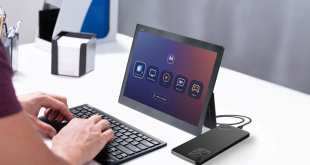Microsoft has been king of the desktop since the beginning of (PC) time, now the firm is ramping up its mobile presence. Jonathan Easton speaks to product manager Robert Epstein about Surface and making Windows work no matter how you use it.
What was the thinking behind Surface and getting into the 2-in-1 space?
Surface was all about highlighting the best of what a Windows laptop, 2-in-1, whatever you want to call it, is and can be. It’s really about our ability to engineer great hardware and software, and innovate in that space to show consumers and businesses how we can give them those innovative and productive tools.
If you think about what Windows is really there for – to empower people and organisations to achieve more and get more done – we wanted to start bringing real innovation to what had been a staid laptop space year in, year out. In terms of recent development, laptops got a bit thinner and at some point somebody took away the CD drive and replaced it with something else. Instead we started to say ‘how do we get more productive?’ Some of that’s in line with Windows’ desire to be the most productive and most personal platform. By which we mean giving people more natural ways of interacting with the device as well. Whether that be touch, or pen, or voice. We’re starting to see people really getting more productive because of all these different technologies.
How was Windows 10 made to make sure that all of those experiences are equal?
One of the benefits of Windows is the choices it gives customers in terms of their ability to chose from a variety of devices, and a huge range of price points and form factors from lots of different manufacturers. The engineering that went into the product, I think, is quite remarkable in terms of bringing all that technology to bear and having it work or not according to the hardware.
So the system’s got to be able to detect whether it’s pen-enabled, and then bring those pen features to life. Some of the beauty for me in Windows 10 was the continuum and that ability to therefore be the best platform depending on the screen you’re using at the time. So if you’ve got a 2-in-1 device and you’re using it in a traditional laptop mode with a keyboard and mouse, what you get is a traditional Windows desktop. And then as soon as you rip the machine apart and turn it into a tablet it needs to naturally become a tablet operating system that’s designed for fingers and for touch.
That needs to feel natural and fluid and that’s certainly the big improvement from the previous iterations that customers saw. So when you detach a Windows machine what is the start menu that people are familiar with naturally through animation grows to be full screen, and then when you reverse that it naturally shrinks back. It becomes very intuitive to the user that they’re on the same machine and things are where they expect them to be, and where they expect them to be as Windows users so they can get the best out of that machine.
We saw some of that in the beginnings of Windows 8 with the start menu there.
Yeah and there was feedback around the jarring of that system. You were either in the desktop or you were in the full start screen. I think we listened carefully to customers and gave them that more natural experience with Windows 10.
“We wanted to start bringing real innovation to what had been a staid laptop space year in, year out.”
Robert Epstein, Microsoft
What way are people using Surface devices primarily? Are they using it as a laptop, or are they taking it out and using it more as a tablet?
It really is entirely up to the user, their circumstance and the scenario that they’re in. That’s why we’ve got the Surface Pro 4, which is – if you like – the tablet that replaces your laptop, and then the Surface Book that is the laptop that becomes a tablet. The Surface Pro is for users who prefer the feel of a tablet: thin, light easy to use as a tablet. And then if you want to use it as a laptop it clicks in, has a built in kickstand so suddenly it feels like a laptop. Certainly with the improvements around this product, it feels like using any traditional laptop. They’ve done this by increasing the rigidity of the keyboard and the way it attaches to the screen which gives you a slight raise.
Now there are some users that wanted to go for an absolute premium keyboard experience, who want a larger touch pad so effectively that is what the Surface Book was about. The other benefit of Surface Book, other than obviously its physically larger form factor, is that it allows us to use the base to put both additional battery and additional graphics performance in some models for people who, whether they’re gamers or designers, really want that here. It feels and looks very much like a traditional laptop with an amazing keyboard and trackpad, and then once you’ve detached it you’ve got a Core i5 or Core i7 device in something that’s under 8mm thick. It’s really great for people in creative industries who need that performance.
With the Surface products do you feel that you have an advantage over OEMs because you’re designing the software and hardware in sync with one another?
I wouldn’t use the term advantage, I’d say we get to innovate and we’ve got some amazing engineers working on Surface that have come from the Microsoft hardware team and that’s from the organisation that’s been building keyboards and mice for 30 years. If you think about what that hardware team has done with innovation it is to improve user experience. Like the wheel on the mouse: that wasn’t to sell more mice, it was to improve Windows’ productive experience.
With Surface, we get to innovate and create amazing 2-in-1 features and form factors. And as you’ll have seen many other OEMs have created a huge innovation of 2-in-1 devices. Most of the major OEMs have something that looks like a Surface Pro – a tablet with a detachable keyboard – and there are other OEMs, you look at Lenovo and what they’ve done with the Yoga range. All of that means that users get highly productive devices that can be a tablet when you need it to be and a laptop when you need it to be.
Where is Microsoft going in the future with mobile computing?
There are declines in the traditional tablet market – and even to some extent in the smartphone market – as people have kind of gone ‘this is about as thin as it can get, with as good a camera as you can get’, so we’re seeing incremental improvements in that space. If anything, the big players in tablets are now starting to push into 2-in-1s following the innovation we’ve had with things like the Surface Pro. I’d like to say that the biggest growth in all device segments is absolutely the 2-in-1. A lot of that has been driven by the innovation of not just Surface, but of the OEM partners as well.
If I think of resellers who are supplying a lot of SMBs; as those owner/managers want to mobilise they’re looking to say ‘great, I want to get rid of my old traditional, probably thick and heavy laptop and the tablet device that I’ve been carrying’ because probably they’re on different platforms and different ecosystems and they’re carrying two devices. If they switch to something like a Surface Pro 4 then they’ve got a single device in a single ecosystem with all their apps, and data, and it’s the most productive machine.
So you’re seeing more businesses gravitate towards 2-in-1s. Do you think that’s the way forward?
Yeah, absolutely. And not just in business. Take students as an example. You want to be on campus and into lectures taking notes. OneNote is built into all of these which will follow you across all your devices including Apple and Android phones, so whatever note you take it’s wherever you go. And those Cortana reminders that you set from a lecture or a business meeting where you can say ‘hey Cortana, add get some milk to my Wonderlist’ it’ll pop up, it’ll notify you next time you’re near a supermarket because Cortana knows where all the supermarkets are, and when I walk past it my phone will pop up and Cortana will just remind me that I’ve done that. Now that reminder is set and that follows me around on all my devices. I can do that with the pen on my Surface, but I can do the same thing with voice. It all just happens. I think in terms of creating these great experiences that just help people be more productive on every single device, Windows gives them that.
Speaking of Cortana, a big part of other voice assistants is integration with the smart home. Is there any plan to integrate Cortana outside of the computer space and have it connected with devices?
We’ve announced an SDK for Cortana that will allow people to effectively integrate Cortana elsewhere, but there have been no announcements of any Microsoft devices specific to that.
Of course, people have in their homes a lot of Windows-based devices and certainly there’s a lot of innovation that’s come in, in terms of far-field communication. The beauty of a lot of these devices is their mic arrays, which allows you to call ‘Hey Cortana’ from across the room and have that work today based on the PCs that people have in their homes.
Cortana is how we bring to life the power of our cloud, big data, and artificial intelligence. We’ve made huge innovations there and huge investment and you’ll continue to see that get stronger and stronger. It’s already on Xbox, it’s on Windows 10 devices, now with an SDK who knows what people will do with it.
 PCR Tech and IT retail, distribution and vendor news
PCR Tech and IT retail, distribution and vendor news



